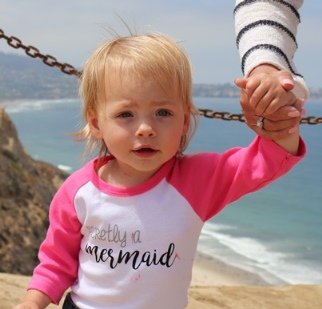
Emma’s heart was in serious trouble. Thanks to the CHET and CVICU teams, she is safe and sound.
By Erica Gadbois
“It’s respiratory — totally normal.” After taking her daughter, Emma, then 17 months old, to the doctor for cold-like symptoms and a fever, Jessica Keene breathed a sigh of relief upon hearing this routine diagnosis. But what was in store for Emma over the coming days would turn out to be anything but.
Emma’s symptoms began to improve, but she then developed a rash and became very lethargic. When she began vomiting in the middle of the night, Jessica and her husband, Marc, called their nurse line for advice. Although they were told it was simply the respiratory virus running its course, the Keenes went with their instincts and rushed her to the emergency room at a hospital near their Del Cerro home.
“They took her back instantly,” recalls Jessica, and Emma was intubated and given CPR. “We were there about an hour and she loses pulse. I thought, ‘I don’t understand – everyone’s been telling us she’s fine.’”
From the time they arrived, physicians had told Jessica and Mark that Emma would be transferred to another hospital but had not yet determined which one. With her condition growing increasingly serious, they called for her transport to Rady Children’s Hospital-San Diego. Soon after, Children’s Hospital Emergency Transport (CHET) team members Julie Kaswick, M.D., Melanie Bisco, R.N., and Nicole Kostek, R.T., arrived at the scene. A vital part of Rady Children’s, CHET provides round-the-clock critical care transport to more than 2,000 Southern California patients each year.
“Just by looking at her, you could tell that her heart was not pumping very well,” says Dr. Kaswick, a fellow in the Rady Children’s and UC San Diego School of Medicine’s Bradley Peterson Pediatric Critical Care Fellowship program. Moving a patient actively undergoing CPR, pediatric or otherwise, from one hospital to another is out of the ordinary. “Any little stress on the body when you’re that critical can cause cardiac arrest,” explains Dr. Kaswick, “and we knew when we moved her that her heart wasn’t going to work.”
However, Emma’s labs revealed something alarming — her tiny body was battling not one, but two viruses, at least one of which was compromising her heart function. Dr. Kaswick, whose research efforts focus on treating respiratory distress, knew Emma needed to be placed on an extracorporeal membrane oxygenation (ECMO) machine. ECMO is a type of cardiopulmonary bypass technology that takes over key functions of the heart and lungs when they cannot perform, supporting recovery and preserving other organs such as the brain and kidneys. Rady Children’s is the only facility in San Diego County to offer ECMO to pediatric patients.
“I think one of the benefits of being at a children’s hospital is that although these [situations like Emma’s] are so unusual, you’ve seen them before,” says Dr. Kaswick. “Literally the only thing that [would] save her life [was] ECMO. Her best chance was to get her to Rady Children’s.”
As anticipated, Emma lost pulse for a second time when Dr. Kaswick, Melanie and Nicole moved her from her hospital bed to their transport gurney, but they leapt into action to stabilize her. “We did CPR from the time we moved her onto our transport gurney, throughout the ambulance ride, and on the walk from the Rady Children’s ambulance bay to the Cardiothoracic Intensive Care Unit. The CTICU then assumed care and continued CPR while she was being placed on ECMO,” recalls Dr. Kaswick. En route to the Hospital, they also coordinated with Rady Children’s colleagues to prepare for Emma’s instant care upon her arrival. “[Dr. Kaswick] was really proactive and made sure everything was set up when we got there,” Jessica notes.
In less than 45 minutes from the time the CHET team delivered the Keenes to the CTICU, John Nigro, M.D., chief of cardiac surgery and director of Rady Children’s Heart Institute and cardiac transplantation and medical assist programs, had Emma on the critical ECMO machine. She then underwent a procedure to relieve pressure on her heart and spent another week on ECMO, 10 days on a ventilator and a month at Rady Children’s as she recovered.
Now 20 months old, Emma is safe and sound at home. “Emma had such an incredible outcome,” marvels Dr. Kaswick. “[It was] definitely one of those cases where everything worked together in the best possible way.”
“The CHET team was amazing,” adds Jessica. “They came back to check on her constantly — they were rooting for her the whole time. When you’re living that, it’s really scary. It feels good to know people are rooting for you.”
With the forward-looking teamwork of Dr. Kaswick, Melanie, Nicole and the CVICU teams in her corner, Jessica says Emma is thriving and unshaken by her journey back to health. “Her last echo[cardiogram] showed her heart function is basically normal, and she’s down to one medication. Aside from some scars, she looks like any 20-month-old.”
Published Summer 2018